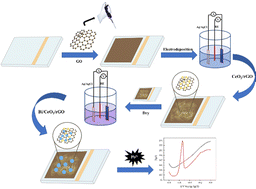In situ electrochemical deposition of a bismuth/cerium dioxide/reduced graphene oxide nanofilm for enhanced Pb2+ sensing performance†
Abstract
A novel bismuth/cerium oxide/reduced graphene oxide (Bi/CeO2/rGO) platform was prepared on an FTO electrode via an in situ electrochemical deposition method, which was employed for the detection of Pb2+. The differential pulse anodic stripping voltammetry (DPASV) results demonstrated that the Bi/CeO2/rGO/FTO sensing platform exhibited good electroanalytical performance. The linear calibration curve for Pb2+ ranged from 0.001 to 2 μM with a detection limit of 0.00045 μM (S/N = 3). The resulting data were compared with some other reported sensors. The present electrochemical sensor possessed high sensitivity, anti-interference ability, stability and reproducibility for the detection of Pb2+. The improved Pb2+ sensing performance was attributed to the synergetic effect, where rGO was employed as a supporter to improve electron transport and CeO2 was used to increase the stability of rGO and prevent the re-stacking of rGO. Calculations based on density functional theory (DFT) revealed that the Bi/CeO2/rGO/FTO possessed lower Gibbs free energy for the detection of Pb2+ in comparison with the rGO/FTO and CeO2/rGO/FTO, which might further explain the improved sensitivity of the Bi/CeO2/rGO/FTO electrode. The proposed Bi/CeO2/rGO/FTO sensing platform was relatively facile, nontoxic and low-cost. Consequently, it was successfully applied for the analysis of Pb2+ in actual water samples.



 Please wait while we load your content...
Please wait while we load your content...